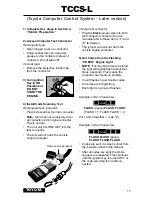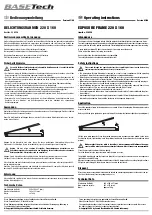
7
Using Codes
Using Trouble Codes to Pinpoint Problems
There are two types of codes
• “Hard” codes - codes for problems
which are present now.
“Hard” problems make the “Check
Engine” light come on and stay on. A
trouble code is stored in computer
memory. The light will stay on as long
as the problem is present.
• “Intermittent” codes - codes for
problems which happened in the
past, but are not happening now.
When the problem first appears the
“Check Engine” light will come on and a
trouble code will be stored in computer
memory. When the problem goes away,
the light will turn off, but the code will
stay in memory.
You troubleshoot the “hard” problems
differently from the “intermittent” ones.
Do a thorough visual and “hands-on”
underhood inspection before starting any
diagnostic procedure!!
Dealing with Hard Codes
These codes are for problems which are
happening now.
• Refer to the vehicle service manual
diagnostic code charts.
• Follow all the steps in the diagnostic
procedure for the trouble code.
• Mechanical problems often generate
trouble codes! Be sure to inspect the
mechanical things suggested in the
diagnostic procedures. Mechanical
problems can make a good sensor
send an incorrect signal to the
computer.
• Do a thorough visual and “hands-on”
underhood inspection before starting
any diagnostic procedure! You can
often find the problem cause and fix it
by doing this. (See “Inspection
Checks”.)
• Be sure to erase the trouble codes
from computer memory after
completing repair work. (Refer to
“Erasing Trouble Codes after Repair”
in the “Reading Codes” section for
your vehicle.)
Dealing with Intermittent Codes
These codes are for problems which
happened in the past, but are not
present now.
• Usually these problems are due to
loose connections or bad wiring. The
problem cause can often be found
with a thorough visual and “hands-on”
inspection. (See “Inspection Checks”
below.)
• Refer to the vehicle service manual
diagnostic code section. You can not
use the code chart procedures
because they are for “hard” problems -
those which are present now.
However, the charts have suggestions
for dealing with intermittents and can
tell you where bad connections, etc.,
might exist.
• Be sure to erase the trouble codes
from computer memory after
completing repair work. (Refer to
“Erasing Trouble Codes after Repair”
in the “Reading Codes” section for
your vehicle.)
Inspection Checks
Doing a thorough visual and “hands-on”
underhood inspection before starting any
diagnostic procedure is essential!!
You can find the cause of many
drivability problems by just looking,
thereby saving yourself a lot of time.
• Has the vehicle been serviced recently?
Sometimes things get reconnected in
the wrong place, or not at all.
• Don’t take shortcuts. Inspect hoses
and wiring which may be difficult to
see because of location beneath air
cleaner housings, alternators and
similar components.
Summary of Contents for Code Scanner CP9025
Page 49: ...49 NISSAN...








































